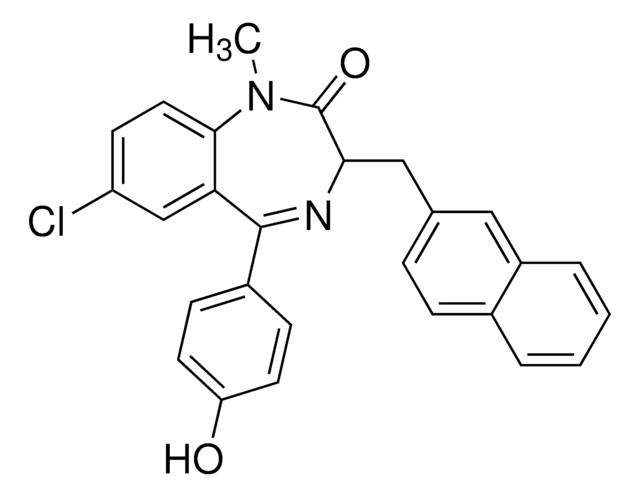495455
Oligomycin
≥90% (mixture of A, B, and C isomers, HPLC), powder, Antibiotic, Calbiochem
Sinonimo/i:
Oligomycin
About This Item
Prodotti consigliati
product name
Oligomycin, A mixture of A, B, and C isomers.
Livello qualitativo
Saggio
≥90% (mixture of A, B, and C isomers, HPLC)
Forma fisica
powder
Produttore/marchio commerciale
Calbiochem®
Condizioni di stoccaggio
OK to freeze
Colore
white
Condizioni di spedizione
ambient
Temperatura di conservazione
−20°C
InChI
1S/C45H74O11/c1-12-34-17-15-13-14-16-27(4)42(51)44(11,53)43(52)32(9)40(50)31(8)39(49)30(7)38(48)26(3)18-21-37(47)54-41-29(6)35(20-19-34)55-45(33(41)10)23-22-25(2)36(56-45)24-28(5)46/h13-15,17-18,21,25-36,38,40-42,46,48,50-51,53H,12,16,19-20,22-24H2,1-11H3/b14-13+,17-15-,21-18+
MNULEGDCPYONBU-ZUSSGZTJSA-N
Descrizione generale
Azioni biochim/fisiol
Membrane-bound mitochondrial ATPase (F1)
Attenzione
Ricostituzione
Altre note
Amoroso, S., et al. 1993. J. Pharmacol. Exp. Ther.264, 515.
Brustovetsky, N.N., et al. 1993. FEBS Lett.315, 233.
Nagamune, H., et al. 1993. Biochim. Biophys. Acta1141, 231.
Note legali
Codice della classe di stoccaggio
11 - Combustible Solids
Classe di pericolosità dell'acqua (WGK)
WGK 3
Punto d’infiammabilità (°F)
Not applicable
Punto d’infiammabilità (°C)
Not applicable
Certificati d'analisi (COA)
Cerca il Certificati d'analisi (COA) digitando il numero di lotto/batch corrispondente. I numeri di lotto o di batch sono stampati sull'etichetta dei prodotti dopo la parola ‘Lotto’ o ‘Batch’.
Possiedi già questo prodotto?
I documenti relativi ai prodotti acquistati recentemente sono disponibili nell’Archivio dei documenti.
I clienti hanno visto anche
Il team dei nostri ricercatori vanta grande esperienza in tutte le aree della ricerca quali Life Science, scienza dei materiali, sintesi chimica, cromatografia, discipline analitiche, ecc..
Contatta l'Assistenza Tecnica.









